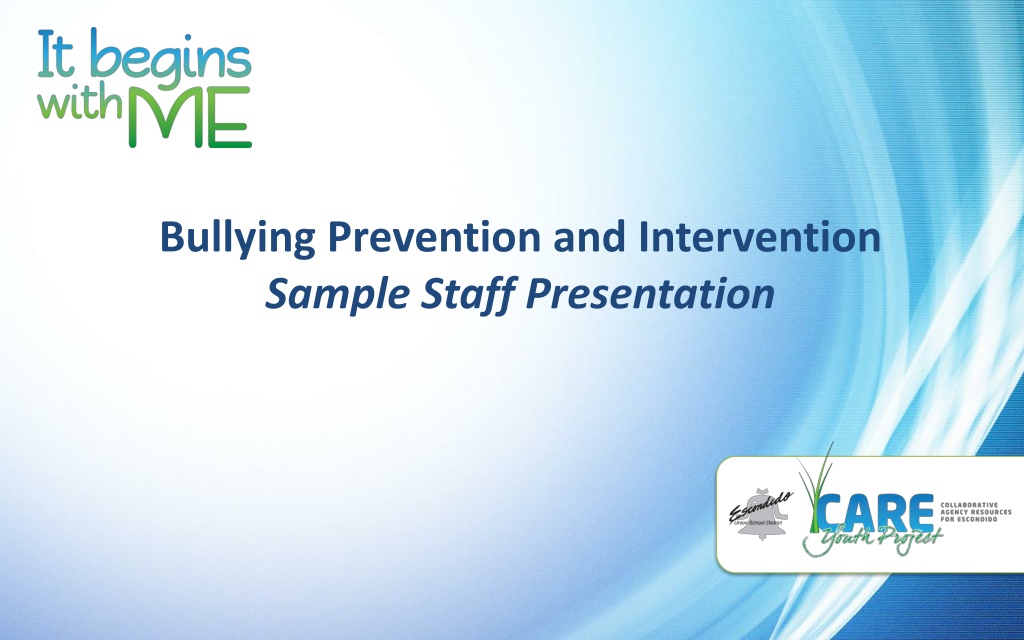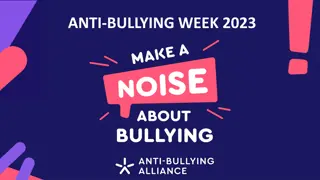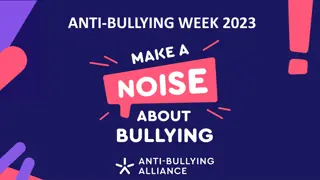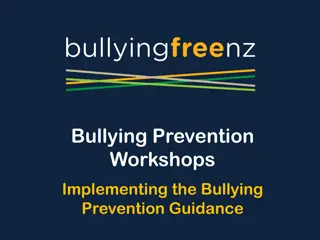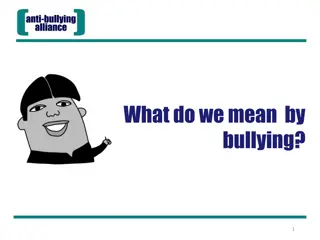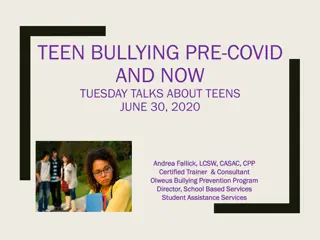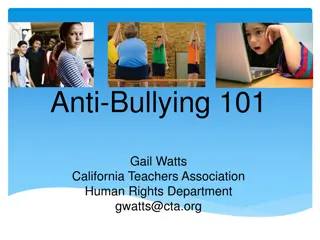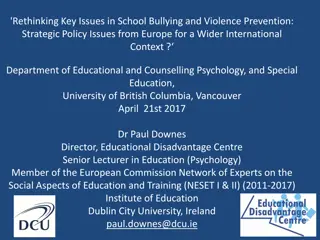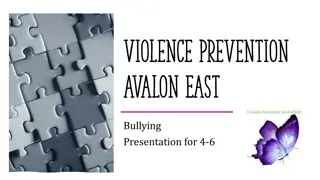Bullying Prevention and Intervention Staff Presentation
Bullying is a form of violence involving power to control and harm others. It can be physical, verbal, or social/emotional, occurring face to face or online. Risk factors for targets and offenders vary, with warning signs including changes in behavior. Prevention strategies include training for staff, lessons for students, and presentations on bullying.
Download Presentation

Please find below an Image/Link to download the presentation.
The content on the website is provided AS IS for your information and personal use only. It may not be sold, licensed, or shared on other websites without obtaining consent from the author.If you encounter any issues during the download, it is possible that the publisher has removed the file from their server.
You are allowed to download the files provided on this website for personal or commercial use, subject to the condition that they are used lawfully. All files are the property of their respective owners.
The content on the website is provided AS IS for your information and personal use only. It may not be sold, licensed, or shared on other websites without obtaining consent from the author.
E N D
Presentation Transcript
Bullying Prevention and Intervention Sample Staff Presentation
What is Bullying? Bullying is a form of violence that involves one or more individuals using power to chronically control and/or intentionally demean, embarrass, or physically harm another individual or group (CDE, 2003).
What is Bullying? Bullying may be physical (hitting, kicking, spitting, destroying property), verbal (taunting, name calling, insults, threatening), or social and emotional (spreading rumors, excluding from activities, humiliating, or intimidating). Bullying may occur face to face or through the internet, cell phones or other electronic means (cyberbullying).
Risk Factors for the Target These traits are common among the target of bullying: socially isolated physically weak or with special needs emotionally reactive or quick tempered lesbian, gay, bisexual, transgender or those who are questioning their identities difficulty with social skills hyperactive obese or overweight anxious/sensitive **Please note: there is no one single profile for a target of bullying.
Risk Factors for the Offender These traits are common among the offender of bullying: impulsive hot-tempered aggressive lack of empathy disregard for rules social leader self-involved **Please note: there is no one single profile for an Offender.
Bullying Warning Signs Possible warning signs that a student is being bullied: difficulty focusing on tasks loss of interest in school work or sudden change in grades appears sad, tearful or anxious complains of headaches or stomachaches experiences a loss of appetite Increase in absences or being tardy to school avoidance of social activities **Warning signs can include any significant behavior change.
Potential Bullying Prevention/Intervention Strategies 1. All staff will participate in a Bullying Prevention and Intervention training annually. 2. All students will participate in (3) bullying prevention lessons during the second week of the school year. 3. All 5th 8thgrade students will participate in Bullying/Cyberbullying Presentations. 4. All parents/guardians will be invited to attend a Bullying/Cyberbullying Parent University Session.
EUSD Bullying Prevention/Intervention Strategies If STAFF witness or hear about bullying taking place: 1. stop the behavior 2. name the behavior 3. remind students of school expectations 4. talk with the target and aggressor separately 5. notify site administrator MEDIATION does not work to reduce bullying behavior.
EUSD Bullying Prevention/Intervention Strategies Be Safe Be Respectful Be Responsible STOP BULLYING It begins with ME!
EUSD Bullying Prevention/Intervention Strategies If STUDENTS witness or experience bullying: Be Safe Stop the bullying right away Avoid situations where bullying occurs Talk to an adult
EUSD Bullying Prevention/Intervention Strategies If STUDENTS witness or experience bullying: Be Respectful Stop the bullying right away Refuse to join in Provide support
EUSD Bullying Prevention/Intervention Strategies If STUDENTS witness or experience bullying: Be Responsible Stop the bullying right away Make a report
EUSD Reporting Procedures take all incidents of bullying seriously notify your site administrator if you witness or hear about bullying taking place in school, in the community, or via the internet through one of the following: In person report Paper incident report Online report (add link here) follow up with the administrator/support staff on interventions/consequences assigned to the target and to the offender
References www.stopbullying.gov For More Information on Bullying Prevention/Intervention www.careyouth.org/schools/bullyingresources
